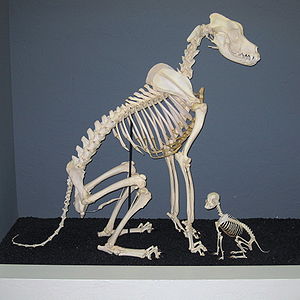Bones - Dog Anatomy
Introduction
This page is concerned with highlighting the bone anatomy of the domestic dog which will include the major aspects of the anatomy and most of the minor elements of anatomy. Very detailed anatomy of individual bones is not covered below due to space restrictions.
The anatomical information included below is commonly split into three separate areas; head, trunk and the forelimbs / hindlimbs. Therefore the following information will use this concept to facilitate easier understanding of the individual areas of anatomy.
Basic Overview
Head
Anatomically the head encompasses all bones cranial to the cervical vertebrae of the neck and is shown in yellow in the diagram above. The head consists of a number of complex bones of varying types and size which will be both described in text and where possible will also be shown photographically.
Trunk
The trunk is in broad terms the body of the animal and is what would remain if the head and limbs were removed. It can be seperated in four parts, the cervical vertebrae (pink above), thorax (orange above), lumbar region (dark blue above) and pelvis (red, label 6 and torquiose above). Anatomically these structures are highly distinguishable and each area has a distinctive shape, size and physiological role.
Limbs
Head
The head is mainly comprised of the skull, mandible, ossicles and hyoid apparatus. Asscessory cartilage is also present within the external ear, larynx and nose.
Skull

The skull comprises of many individual bones that are fused together to form a strong single structure. These individual bones in adults are fused via ossification of the cartilage between bones that is found in young animals. The classification of bones within the skull is based on the traditional views of skull drawings such as the historical drawing shown above.
Trunk
Forelimb

